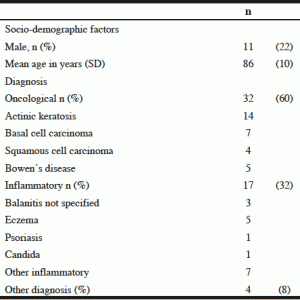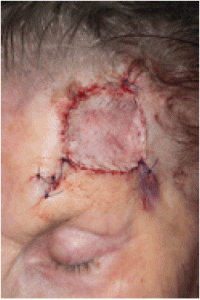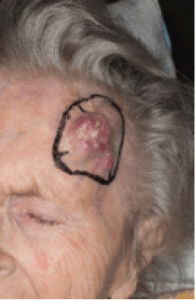M.S. Klapwijk1,3, S.T.P. Kouwenhoven2, W.P. Achterberg1, M.H. Vermeer4
1. Department of Public Health and Primary Care, Leiden University Medical Center, the Netherlands; 2. Mohs Klinieken, Dordrecht, the Netherlands; 3. Marente, Leiden, the Netherlands; 4. Department of Dermatology, Leiden University Medical Center, the Netherlands. Corresponding author: Maartje S. Klapwijk, Leiden University Medical Center, Department of Public Health and Primary Care, P.O. Box 9600, 2300 RC Leiden, the Netherlands, E-mail: m.s.klapwijk@lumc.nl, Telephone number: +31715268444
Jour Nursing Home Res 2019;5:56-59
Published online October 1, 2019, http://dx.doi.org/10.14283/jnhrs.2019.10
Abstract
Abstract: Skin diseases are predominantly non-lethal, but can have a significant impact on quality of life in older people living in a nursing home. This short report shows the results of consultations of a dermatologist visiting people in a nursing home. The frequency of the visits was 3-4 times a year, from June 2013 to December 2016. This is the description of all consultations of fifty residents, seen during eleven visits, 53 treatment plans were made. Sixty percent of consults were on suspected oncological conditions and treatment decisions were often more reticent due to impairment in mobility, life expectancy and comorbidities. The model (visiting dermatologist in nursing home) was evaluated as very valuable complementary care alongside normal dermatological care provided by the physician in the nursing home and the possibility of telemedicine. This type of palliative dermatological care in cooperation between a hospital and a nursing home is worth being studied.
Key words: Dermatological care, long-term care, dementia care, nursing home medicine, palliative care.
Introduction
Increasing age is associated with several dermatological problems (1). Even though skin diseases are predominantly non-lethal, they can have a significant impact on the quality of life in older persons. The different needs for older adults with dermatological problems have to be addressed (2, 3), also for those who are residing in a nursing home (4). The dermatological care of this specific group demands a type of care that might differ from (inter)national guidelines due to an impaired life expectancy, comorbidities and extensive functional impairments. Many nursing home residents are unable or unwilling to visit a hospital or outpatient dermatology clinic because of these impairments. Furthermore, only a minority of dermatologists visit patients in a nursing home, barriers found were lack of time and/or financial compensation (5).
This study explored whether regular site visits by a dermatologist to a nursing home facility, sometimes in combination with a short visit of the patient to the outpatient clinic, could provide a time and cost-effective dermatological care model for this vulnerable group. This short report evaluates the experiences of this three-year project. In particular, it describes the dermatological conditions that were diagnosed and what treatment options had been chosen, and with what results.
Methods
We describe demographics, diagnosis, method of treatment and follow-up of dermatological consultations in a 180-residents nursing home from June 2013 to December 2016.
The nursing home had six different wards for 30 patients each; one for geriatric rehabilitation, two for chronically ill people, two for people with dementia and one for gerontopsychiatric care.
All the residents received medical care by an elderly care physician that gave geriatric care medical care, including routine dermatological care (6).
A dermatologist from a nearby hospital visited the nursing home 3 to 4 times a year to see all residents that needed consultation together with one of the nursing home’s physicians. This physician decided who needed consultation and all patients were consulted in their own room with one of the nurses from the ward present.
In the large majority of the cases (n=41) the dermatological diagnosis was made by the dermatologist based on the clinical presentation. In 12 cases biopsies were made. Depending on comorbidities, mobility, medication, treatment wishes (resident/relative) and life expectancy, a treatment plan was made jointly by the dermatologist and the elderly care physician in consultation with resident and relatives. All diagnoses were subdivided in oncology, inflammatory or other. The clinical data that were used for this study were routine care data, and were anonymously placed in a separate file for evaluation purposes. Therefore, no ethical approval was needed. Demographic statistics were calculated using SPSS, version 24.
Results
From April 2013 to December 2016, 50 residents were visited by a dermatologist, an elderly care physician and nurse during eleven moments of consultations in one nursing home. In total, 53 visits were made to eleven male patients and 39 female patients, two males and one female had two different consultations. The mean patient age was 86 years, see table 1. The distribution of consulted patients was as follows; ten visits to people on the dementia special care unit, 28 visits to people on the units for chronically ill people, five visits to people admitted to the geriatric rehabilitation unit and ten visits to people admitted to the gerontopsychiatric unit. The reason for admittance to the nursing home varied from dementia, cardiovascular diseases, neurological disorders, diseases of the musculoskeletal system to other less common comorbidities. The total number of people that was diagnosed with dementia in the entire group was 21.

Table 1
Baseline characteristics of the study population, 53 consultations in the nursing home (50 residents)
SD=Standard deviation
At least 37 patients (70%) were bedridden and/or wheelchair bound and were dependent on other parties (e.g. ambulance, wheelchair taxi service) than family, friends or relatives to visit a hospital or outpatient clinic.
The dermatologist was most frequently consulted for suspected oncological conditions, including pre-malignancies (n=32, 60%). Fourteen cases of actinic keratosis and five M. Bowen were diagnosed. Three of the M. Bowens cases were treated with excision, while all of the actinic keratosis cases were treated with cryotherapy at the moment of consultation. Basal cell carcinoma (BCC) was found seven times. Two BCC were radically excised with adequate free tumour margins, while five cases were not treated after consultation between elderly care physician, dermatologist, patient and/or family. All of the four squamous cell carcinomas (SCC), that were initially diagnosed clinically, were treated with surgical excision in a single visit to the hospital. The diagnosis was histologically confirmed in all of the excised tumours. Two of the clinically extensive SCC’s were excised irradically. In both cases this was to be expected, due to extensive growth and clinically immobile in relation to the underlying tissue, see figure 1.

Figure 1
Example of one of the residents with an SCC before and after excision. Wound closure with a full thickness skin graft
(We have permission for publication from the relative)
Two tumours that were excised under suspicion of a BCC appeared to be cases of actinic keratosis, meaning that, retrospectively, these patients were overtreated. Benign skin abnormalities, classified as other diagnoses, were found in four patients (8%). Two of these lesions (e.g. seborrheic keratosis) were treated with cryotherapy at the time of the consultation, because the patients appeared to scratch or traumatise the lesions and wanted these to be treated.
Seventeen of the consultations concerned a heterogeneous group of inflammatory dermatoses, see table 1.
There were no surgical complications. The only registered complications occurred after cryotherapy and consisted of blistering (two cases) and superficial infection (one case) that was treated effectively with topical antibiotics.
One year after the last consultation 15 of the 50 consulted patients were still alive. None of the 35 deceased patients passed away as a result of the dermatological condition or related complications.
Discussion
The burden of dermatological diseases in the aging population is rising. This is, to our knowledge, the first study to describe the dermatological consultation in a large group of residents living in a nursing home. The strategy of dermatologic consultations in a frequency of three or four times a year in local nursing homes to treat a variety of (pre-)malignancies and inflammatory skin diseases seems to be a feasible way to provide population-specific care for the often immobile, nursing home resident. The majority of the consultations were about (pre-)malignancies. This type of population-specific healthcare, divergent from guidelines or protocols, led to a good disease free survival and an ignorable risk of complications. Only the treatment of malignancies that were thought to cause significant harm like pain or ulceration and infection (like the example), required a single visit to the hospital.
One frequently used option in the Netherlands, also in nursing homes, is teledermatological care, when question and picture(s) are sent to a dermatologist using a store and forward (SAF) technique, with a safe online connection (7, 8). We believe that the consultation care model is valuable next to the teledermatological care. Sometimes consultation by a dermatologist is necessary due to non-responsiveness of the initiated treatment, uncertainty about the diagnosis via a picture, or treatment that requires specific dermatological skills, for instance in case of a suspected malignancy. Interestingly, there were no consultations regarding pressure sores, which may be related to the quality of prevention and management present in the nursing home.
In the regular setting in the dermatology department, patients are referred to the outpatient clinic for a visit. A skin biopsy is performed for histology for diagnosis or – in the event of a clinically evident malignancy – to determine the feasible treatment, depending on the growth pattern or subtype. The diagnosis and treatment options are given a week later and subsequently a treatment plan is offered that often includes surgical excision. In other cases, a malignancy is excluded on clinical grounds and the patient can be reassured. This practice conforms to national and international guidelines (9).
The model (visiting dermatologist in the nursing home) was evaluated as very valuable complementary care alongside the regular dermatological care provided by the physician in the nursing home and the possibility of telemedicine, as already suggested by Lubeek and colleagues (10, 11). The point of view and opinion on possible treatment options of the patient and his/her family/caretaker needs to be respected and, preferably, be clear before the consultation. Five out of seven basal cell carcinomas were left completely untreated with informed consent following communication between elderly care physician, dermatologist, patient and family. However, we also found two cases of potential overtreatment in two residents with visual suspicion of a BCC, which histologically appeared to be actinic keratosis.
Our results show the potential and need for tailored dermatological care, in a cooperation model between hospitals and long-term care facilities.
We believe this type of dermatological care can help residents in nursing homes to obtain a quick diagnose and treatment plan without extra visits to the hospital. This kind of dermatological care in the nursing home should be further studied, also regarding the feasibility of organization and cost-effectiveness.
Conclusions and Implications
This type of (palliative) dermatological care in cooperation between a hospital and a nursing home can be very valuable for older adults in nursing homes and is worth being studied in order to be organized on a structural basis.
Conflict of interest: All the authors declare that there are no conflicts of interest. The work presented here has not been published elsewhere.
Funding: This research did not receive any funding.
References
1. Chang AL, Wong JW, Endo JO, Norman RA: Geriatric dermatology review: Major changes in skin function in older patients and their contribution to common clinical challenges. Journal of the American Medical Directors Association 2013, 14(10):724-730.
2. Linos E, Chren MM, Covinsky K: Geriatric Dermatology-A Framework for Caring for Older Patients With Skin Disease. JAMA dermatology 2018.
3. Garcovich S, Colloca G, Sollena P, Andrea B, Balducci L, Cho WC, Bernabei R, Peris K: Skin Cancer Epidemics in the Elderly as An Emerging Issue in Geriatric Oncology. Aging and disease 2017, 8(5):643-661.
4. Lubeek SF, van der Geer ER, van Gelder MM, Koopmans RT, van de Kerkhof PC, Gerritsen MJ: Current Dermatologic Care in Dutch Nursing Homes and Possible Improvements: A Nationwide Survey. Journal of the American Medical Directors Association 2015, 16(8):714.e711-716.
5. Lubeek SF, Van Der Geer ER, Van Gelder MM, Van De Kerkhof PC, Gerritsen MJ: Dermatologic care of institutionalized elderly patients: a survey among dermatologists in the Netherlands. European journal of dermatology : EJD 2015, 25(6):606-612.
6. Koopmans RT, Lavrijsen JC, Hoek JF, Went PB, Schols JM: Dutch elderly care physician: a new generation of nursing home physician specialists. Journal of the American Geriatrics Society 2010, 58(9):1807-1809.
7. Lubeek SF, Mommers RJ, van der Geer ER, van de Kerkhof PC, Gerritsen MJ: [Teledermatology within Dutch nursing homes]. Tijdschrift voor gerontologie en geriatrie 2016, 47(3):117-123.
8. Trettel A, Eissing L, Augustin M: Telemedicine in dermatology: findings and experiences worldwide – a systematic literature review. Journal of the European Academy of Dermatology and Venereology : JEADV 2018, 32(2):215-224.
9. Kim JYS, Kozlow JH, Mittal B, Moyer J, Olencki T, Rodgers P: Guidelines of care for the management of basal cell carcinoma. Journal of the American Academy of Dermatology 2018, 78(3):540-559.
10. Lubeek SF, van der Geer ER, van Gelder MM, van de Kerkhof PC, Gerritsen MJ: Improving Dermatological Care for Elderly People Living in Permanent Healthcare Institutions: Suggestions from Dutch Dermatologists. Acta dermato-venereologica 2016, 96(2):253-254.
11. Lubeek SF, van Gelder MM, van der Geer ER, van de Kerkhof PC, Gerritsen MJ: Skin cancer care in institutionalized elderly in the Netherlands: a nationwide study on the role of nursing home physicians. Journal of the European Academy of Dermatology and Venereology : JEADV 2016, 30(12):e236-e237.

